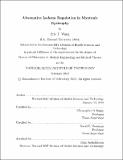Alternative isoform regulation in myotonic dystrophy
Author(s)
Wang, Eric T. (Eric Tzy-shi)
DownloadFull printable version (27.18Mb)
Other Contributors
Harvard--MIT Program in Health Sciences and Technology.
Advisor
Christopher B. Burge and David E. Housman.
Terms of use
Metadata
Show full item recordAbstract
Myotonic dystrophy (DM) is the most common form of adult onset muscular dystrophy, affecting more than 1 in 8000 individuals globally. The symptoms of DM are multi-systemic and include myotonia, severe muscle wasting, cardiac arrhythmias, cataracts, gastrointestinal dysfunction, and cognitive deficits. DM is caused by the expansion of CTG or CCTG repeat sequences expressed in noncoding portions of RNA, which sequester or activate RNA splicing factor proteins, leading to widespread deleterious changes in transcriptome isoform usage. We developed a method for studying transcriptomes, RNAseq, which provides a high resolution, digital inventory of gene and isoform expression. By applying RNAseq to human tissues and cell lines, we discovered that essentially 92-94% of all human genes are alternatively spliced, 86% of them with a minor isoform frequency 15% or more. We found that the majority of alternative splicing and alternative polyadenylation and cleavage events are tissue-regulated, and that patterns of these RNA processing events are strongly correlated across tissues, implicating protein factors that may regulate both types of events. We applied this method towards the goal of identifying transcriptome changes occurring in DM, focusing on the Muscleblind-like (MBNL) family of RNA binding proteins, which are functionally inactivated by CUG or CCUG repeats. Using RNAseq to profile tissues and cells depleted of MBNLs, we found that MBNL1 and MBNL2 co-regulate hundreds of redundant targets. MBNL1 UV cross-linking and immunoprecipitation, followed by sequencing (CLIPseq), was used to identify the in vivo transcriptome-wide binding locations of MBNL1, and facilitated the construction of a context-dependent RNA map for MBNL1 splicing regulation. Extensive 3' UTR binding of MBNL1 was found to localize mRNAs to membrane compartments of mouse myoblasts, suggesting a new global function for MBNLs, and additional mechanisms by which MBNL depletion can lead to DM symptoms.
Description
Thesis (Ph. D.)--Harvard-MIT Program in Health Sciences and Technology, 2012. Cataloged from PDF version of thesis. Includes bibliographical references.
Date issued
2012Department
Harvard University--MIT Division of Health Sciences and TechnologyPublisher
Massachusetts Institute of Technology
Keywords
Harvard--MIT Program in Health Sciences and Technology.